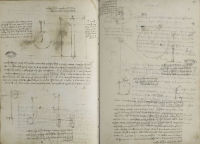Rule of Mathematics Click on the thumbnails to explore the trail
Read more about this trail (expand)
Leonardo believed that all things in nature were governed by mathematics. Mathematics was of supreme importance and expressed incontrovertible, universal truth. Knowledge of mathematics was a prerequisite for understanding the nature of all things. “Let no-one who is not a mathematician read my principles”, Leonardo said. Geometry and its actual or potential relationship to natural forms provided a suitably visual means for the exploration of mathematical “truths”.

- Enlarge
- Zoom & explore
- Fol 20v-21r - Measuring the distance of the sun. Photo RMN - © René-Gabriel Ojéda
Paris Manuscript A c1492
No problem was too great for Leonardo! On sheet 21r, he describes an imaginative method for finding “the true height of the sun”.
First, we must find two mountains within sight of each other, “as far apart as possible and of the same height”. We must then position ourselves on the summit of one and a friend ‘who is diligent’ on the other, and both build wooden huts with small apertures through which the sun may shine. When the sun makes a perpendicular angle in the first hut, a ready-prepared fire must be lit. This will make a large cloud of smoke that will alert our friend, who will then mark the point where the sun enters their hut. The result is the creation of a right-angle triangle as illustrated in the drawing, from which the result in theory would be calculable by simple trigonometry.
Giovanni Cassini made the first scientific measurement of the earth-sun distance in 1672 by calculating the distance of Mars. It is worth noting that he did so by observing Mars from two places at the same time.
In Leonardo's words
There is not to be seen in the universe a body of greater magnitude and power than the sun; and its light illuminates all the celestial bodies distributed through the universe; and the life forces descend from it, because the heat which is in living animals comes from life forces and no other heat is there in the universe, as will be shown in the fourth book.
Various subjects are covered in this manuscript including painting, perspective, water and mechanics.
Theories regarding painting expounded here provide the basis for much of the Codex Urbinas and consequently the treatise on painting. Leonardo’s recommendations to the painter regarding the execution of the perfect portrait are of particular interest.
Although dated 1492, the notes may have been begun earlier, around 1490. Manuscript A is a fragment of a manuscript which comprised originally of 64 folios including the Codex Ashburnham II.
- Medium Pen and ink on paper
- Size 22 x 15 cm
- Location Bibliothèque de l’Institut de France










